A whole generation grew up watching The Saddle Club, and pony clubs were swamped as a result. But long before that phenomenon, a whole different generation grew up watching Roy Rogers and Trigger… and yodelling was briefly in fashion!

“We never got hurt by
horses — only by trees!”
THE SADDLE CLUB (2001-09)
It had a catchy theme tune, exciting storylines and, most important of all, it had horses. Scores of them. This iconic TV series was a tween’s dream. It followed the exploits of Stevie (Sophie Bennett), Carole (Keenan MacWilliam) and Lisa (Lara Jean Marshall), who formed the Saddle Club at Pine Hollow Stables. (The cast changed by the third series as the leading actors had outgrown their roles).
Club members had lovely horses kept at a wonderful riding school bordered by picturesque trails. A new adventure happened each week to members and their friends and every episode featured the many different challenges of growing up. And some of the girls would sing as well.
“Together they could do anything,” claimed the producers, “and we thought that was a great message to send to all kids.” According to one market researcher, the success of the show stemmed from its theme of friendship: “A tween’s greatest fear is loneliness. Having friends is absolutely pivotal.”
The joint Australian-Canadian TV series, which was a hit in 15 countries, was inspired by a collection of books written by American Bonnie Bryant, who initially knew little about all things equestrian, tending to write about Delilah, a palomino thoroughbred, and a buckskin Trakehner named Starlight. Clearly readers never noticed such descriptive lapses, or they didn’t care, and since the publication in 1988 of Bryant’s first title, Horse Crazy, more than 16 million books in the 110-title series have been sold worldwide.
All Saddle Club episodes were filmed in various regions of Victoria and, by the end of the second series, more than $9 million had been injected into that state’s economy. It also put money into the pockets of writers, technicians, cameramen, editors, tutors (who schooled the young actors on set) editors, wranglers and, of course, the horse master.
Graham Ware Jnr worked on all three seasons. “In 2000 we worked at Wandin Riding School with production offices and sets based at Springhurst. For the second season all sets were built on a location at Hurstbridge and, for the third and final series, everything was at Daylesford,” explains Graham, whose Performance Livestock Company is based at Yarramundi 70km west of Sydney.
“We used 38 horses for the first season and 45 in the second and third. I’d take down 30 and sourceed more from Melbourne. To get them started for the first two weeks the girls had lessons on the riding school’s horses, and then they did four weeks of boot camp on our horses. None was a rider before being cast in the show.”
However, Canadian actor Sophie Bennett, who scored the role of Stevie, says she was the only cast member who knew how to ride, having ridden since she was five. Graham, however, doesn’t recall her being better than any of her co-stars… “but neither was she cocky or superior. All the kids were respectful and hung off our every word. They tried hard and learnt to walk, trot, canter and do some cavaletti work in an arena.”
Sophie is now a freelance producer, writer and low-key influencer in Canada with her own YouTube channel. She recalls the fun she had 20 years ago, and says: “And we never got hurt by horses — only by trees!”

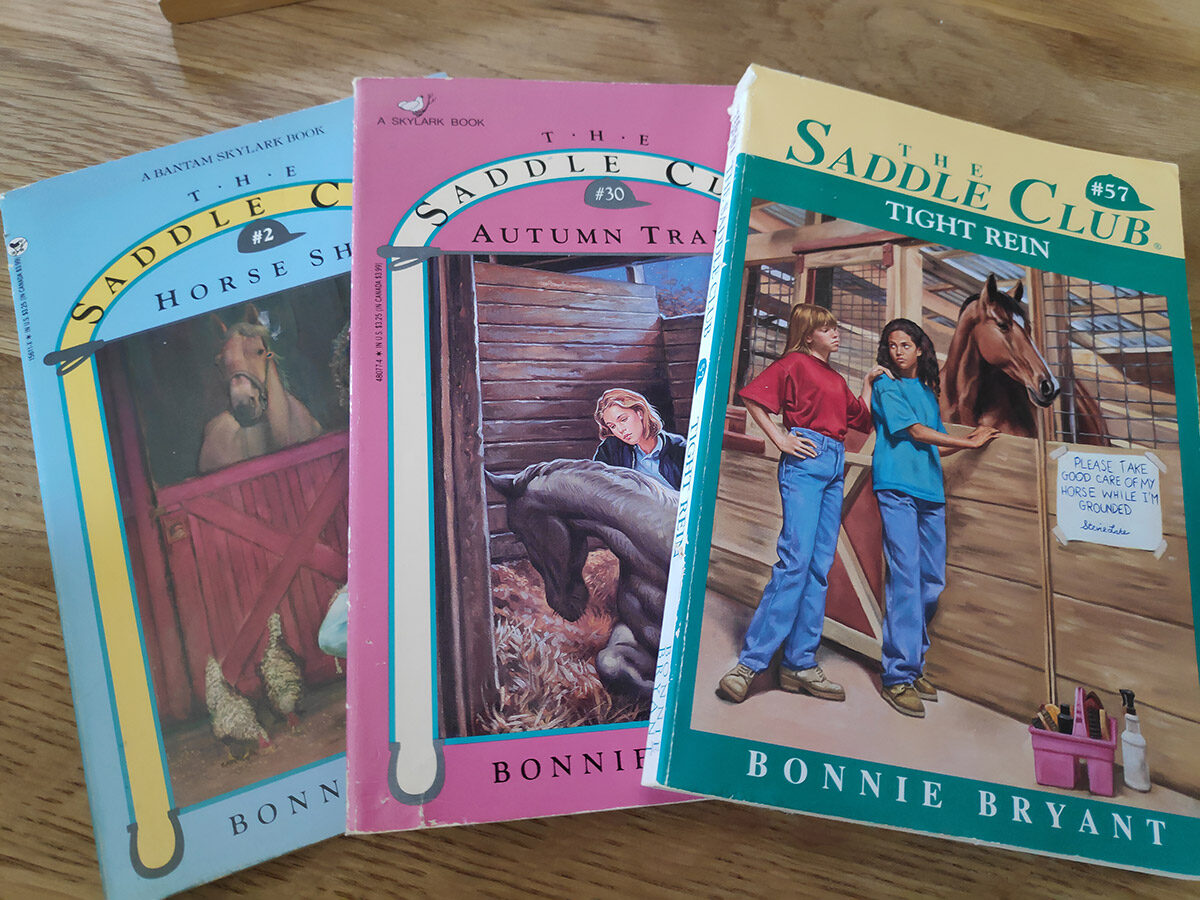
“The little girls with mouths
agog and eyes like dinner plates
waved and wished even
harder for a pony.”
There are no records of any of the many TSC members going on to pursue equestrian professions. Lara Jean Marshall, who played Lisa Atwood, says she enjoys some pleasure riding these days. Her latest acting role is a far cry TSC though. Now 30, she plays a villain in the sci-fi series We Were Tomorrow, in which she repeatedly stabs people. Her favourite SC horses were Prancer and Patch. Keenan MacWilliam, who is presently a producer at Herself, a feminist art website, once stated she really liked Starlight and Cobalt.
These four horses, like the other nine in the cast, each had a double. “And then we had 15 as background which were speciality horses,” said Graham. (These were trained to rear on command, run to a mark, push objects, nod, lie down, bow, kneel, sit and fetch). “A lot of the show was based on guest actors who’d do a couple of eps and then disappear. This was when we’d use one of our specialties.”
On one occasion a scene called for a “sick” horse to lie on the ground and be examined by vet assistant, George Whiteside, played by a 19-year-old Chris Hemsworth. At the time nobody thought he would go on become a muscular superstar making millions in Hollywood! Both he and the horse performed the sequence splendidly. “I worked with Chris recently when I was the horse master and animal trainer on Thor – Ragnarok,” says Graham.
On TSC, Graham always worked closely with the producers. “I was given a lot of lead time and never thrown in the deep end. I’d also be asked to put forward storyline ideas.”
For much of the time he collaborated with the late Lynn Bayonas, who once said: “With any production you have hair-raising moments, but I think the combination of children and animals works a treat – they get such a buzz out of working together, too.”
“Lynn always was keen to showcase the horse work and welcomed suggestions,” says Graham. “And after a day’s filming I’d be shown the rushes and asked to select which scenes looked the most realistic.”
Some smart alec viewers would ask why the stabled animals always wore headstalls. “Because when a shot was required of an actor standing with her horse, she could put her hand up onto the headstall and control its head so it looked towards the camera,” says Graham.
The only thing he couldn’t control was the overuse of neighing, whinnying and nickering – a problem which exists today in almost all horse films. These inappropriate sound effects are put in by overzealous editors in post-production and have been happening ever since talkies were invented.
Like the horses, the SC girls had doubles who would stand in for them when a scene required rearing, galloping or falling and such — but when many of them had to appear in The Saddle Club Live Show, a spectacular held in the Sydney Super Dome in 2004, there was no opportunity for back-up. They were on their own with 30 horses.
The girls nailed it, proving to 7000 spectators they could walk, trot, canter and sing at the same time. The Sydney Morning Herald’s review of the show in April was most impressive: “The girls are excellent riders and the horses are highly trained. A climactic race showed their extensive experience. Nearly all dealt with horses spooked by camera flashes from the audience, despite warnings before the show. For the finale our horsey heroines waved to the crowd like radiant royalty as they whizzed past in a white horse-drawn carriage with roses attached to the sides. And the little girls with mouths agog and eyes like dinner plates waved and wished even harder for a pony.”
Graham still has happy memories of those times. “In those live performances and in all three TV series the cast was fantastic and always respectful of the horses, three of which I still have in the paddock at home. They’re in their 30s now and doing well.” Graham is currently in Byron Bay working with small animals on Nicole Kidman’s Nine Perfect Strangers.
It’s been a while since Kidman was filmed in the saddle; Baz Luhrmann’s Australia (2008) was probably the most recent picture. Many of the horses for that $130 million production came from equestrians such as Daniella Dierks, George Sanna and this magazine’s very own Roger Fitzhardinge. But more on all that next time!
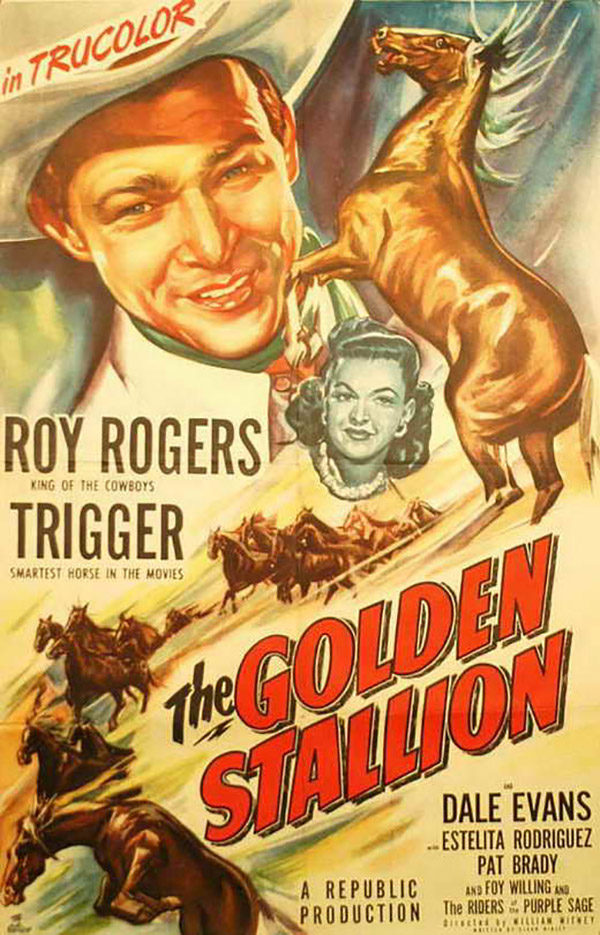


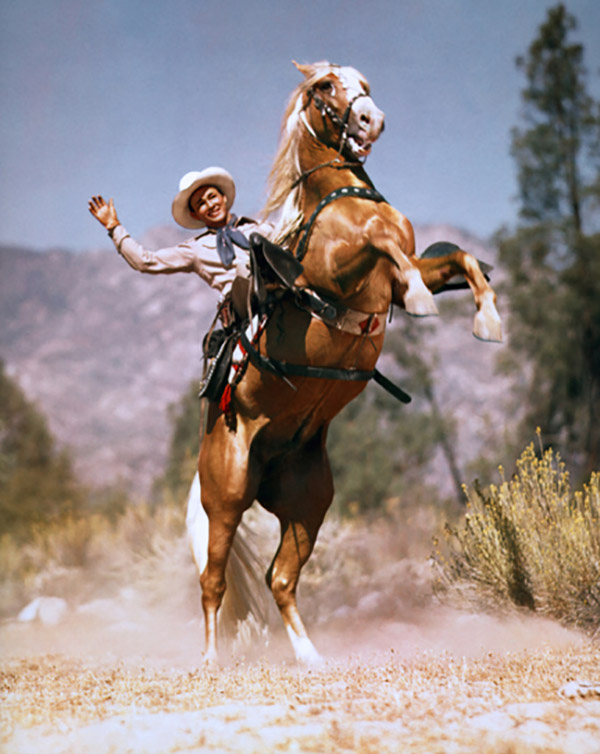
TRIGGER (1932-65)
Leonard Slye was never going to have his name up in lights. No self-respecting moviegoer would rush to the box office to watch someone who sounded like a dodgy accountant or a taxidermist. Although they might have unknowingly seen him yodelling in a second-rate western.
Sometime in the late thirties, Republic Pictures held a “singing cowboy” competition. Leonard Slye entered and won… but the production company immediately changed his name. He became Roy Rogers, King of the Cowboys who rode a palomino named Trigger – the Smartest Horse in the Movies.
The rest is history.
Originally named Golden Cloud, the 15.3hh stallion was by a thoroughbred out of a draft mare (other records have stated she was a quarter horse). Gold Cloud remained entire all his life but was never used at stud.
Initially Rogers trained him to perform simple tricks but later sought the help of Glenn H. Randall Snr, who had previously trained Champion the Wonder Horse for Gene Autry. He taught the stallion to paw the ground, shake hands, bow, mule kick and, of course, rear on command.
But in movies things aren’t always as they seem. What spellbound audiences were often watching was not the hero horse showing off, but his double, Little Trigger, whose breeding was unknown. Just 15hh, he had a light dappled coat, different face and four stockings. (The real Trigger had only one on his offside hind and a blaze extending over his left eye and down over the right nostril).
It was this chunky little substitute who earned the star the “smartest horse” title. He knew well over 160 tricks and routines and could perform many complicated dressage moves. He was often used when a scene required a potentially hazardous manoeuvre.
Rogers rarely mentioned Little T but he did acknowledge another palomino, Trigger Junior, describing him publicly as Trigger’s understudy whose job was being Rogers’ personal appearance horse in the fifties and sixties. Junior was a Tennessee walking horse, registered as Allen’s Gold Zephyr and, according to his owner, ‘wasn’t worth a nickel as a cowboy horse, but could sure do a pretty dance routine’. Which was perfect for entertaining youngsters around the country.
And there were three more doubles, generally used for long-distance running scenes, named Monarch, California and Pal.
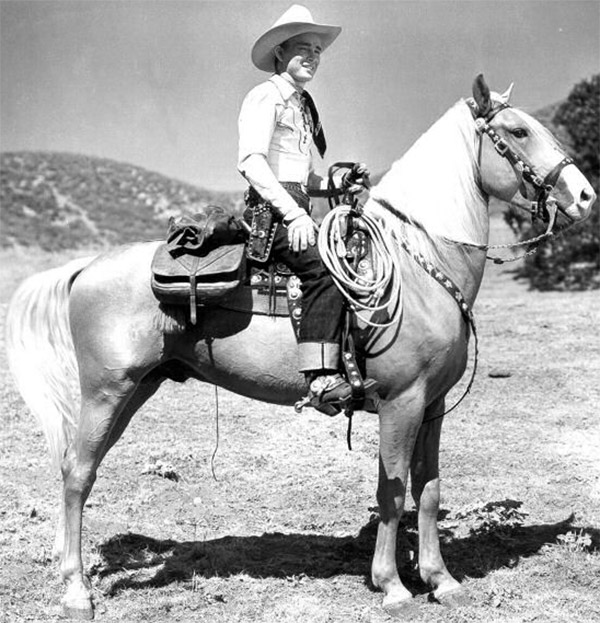
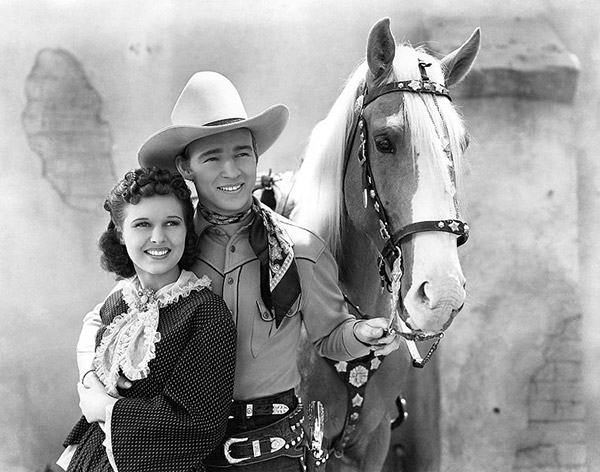
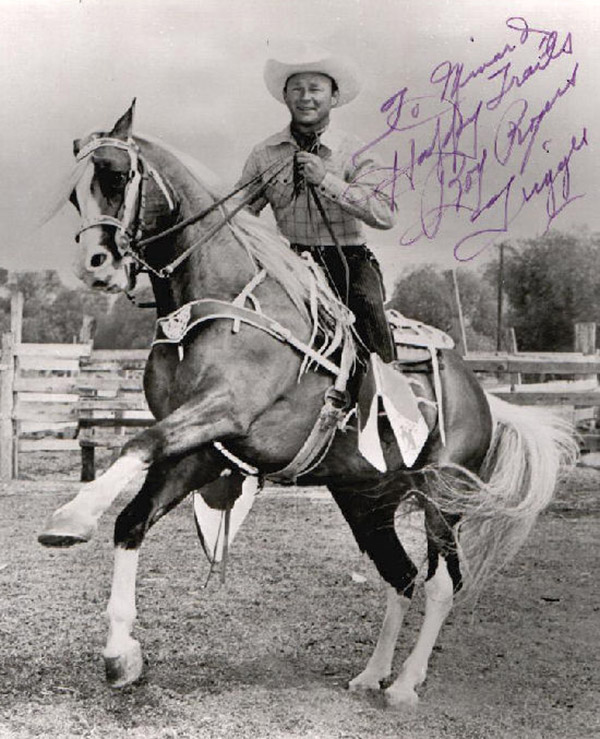
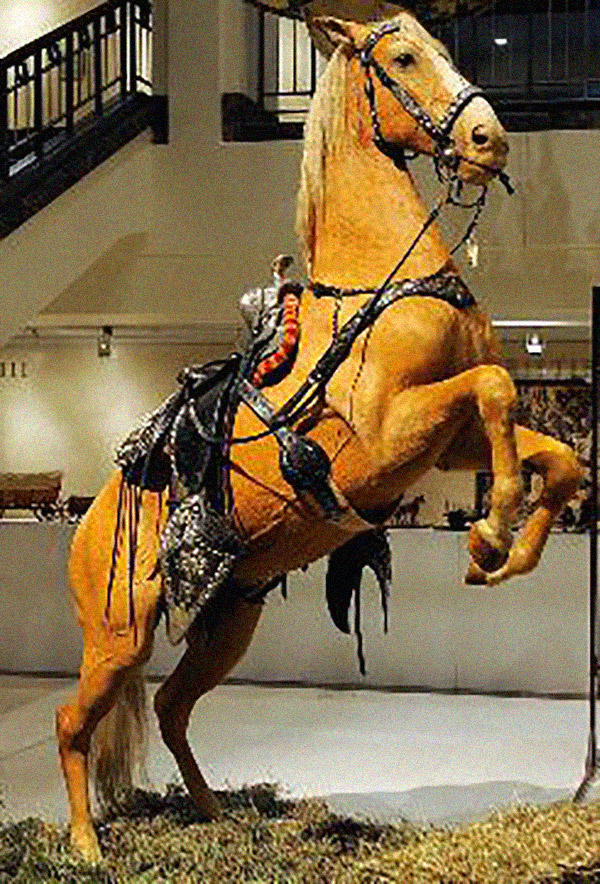
“Today they’re making
pictures that I wouldn’t
want Trigger to see.”
When Trigger and Junior died, America’s most popular cowboy had them mounted and displayed in his museum; no one knows what happened to the three long-distance doubles or the supremely talented Little Trigger. Rogers did once admit, though, he was sad he hadn’t had him mounted and displayed next to the other two.
The Roy Rogers – Dale Evans Museum opened in 1967 in California, moving to Missouri in 2003 before closing six years later. In 2010, some of its exhibits were auctioned at Christie’s in New York City. RFD-TV, a Nebraska cable network, paid $266,500 for Trigger and $35,000 for Rogers’ German shepherd, Bullet. “Roy reflects the company’s values,” proclaimed the chief financial officer of the network which broadcasts agricultural, equine and country living programs. In August last year, the stuffed couple were transported in temperature-controlled containers from Nebraska to The Cowboy Channel’s recording studios in Fort Worth, Texas.
Trigger had retired in 1957 to a property near his owner’s home, dying peacefully in 1965 aged 33. Rogers was 86 when he died of congestive heart failure in 1998. His body was prepared in the conventional way and conveyed in a glass-enclosed 1898 hearse drawn by a single Clydesdale. Mourners dressed in old western garb.
His image was always squeaky clean. His natty shirts were perfectly pressed and his hat sat tidily on his head however fast he galloped. He was nothing if not wholesome and never embraced the more modern gritty films. “Today they’re making pictures that I wouldn’t want Trigger to see,” he famously said after he retired. But Roy just might have been interested in one movie made in 2019…
In Tarantino’s Once Upon a Time in Hollywood, Rick, played by Leonardo DiCaprio, has a movie poster on his wall. It features Rogers in The Golden Stallion, made in 1949 — because westerns are Rick’s favourite genre! EQ



